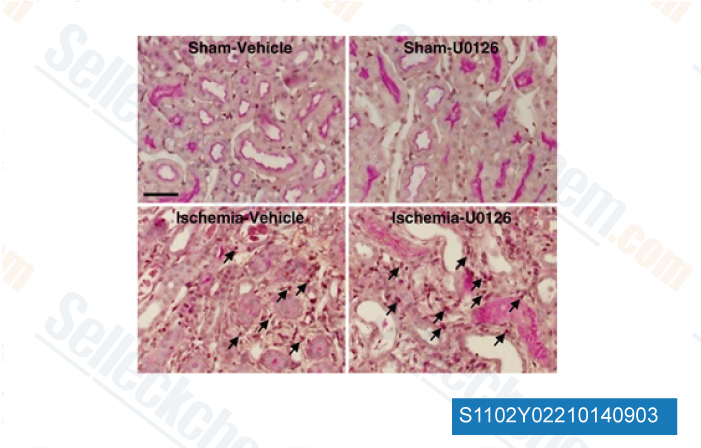|
Toll Free: (877) 796-6397 -- USA and Canada only -- |
Fax: +1-832-582-8590 Orders: +1-832-582-8158 |
Tech Support: +1-832-582-8158 Ext:3 Please provide your Order Number in the email. |
Technical Data
| Formula | C18H16N6S2.C2H6O |
|||
| Molecular Weight | 426.56 | CAS No. | 1173097-76-1 | |
| Solubility (25°C)* | In vitro | DMSO | 85 mg/mL (199.26 mM) | |
| Water | Insoluble | |||
| Ethanol | Insoluble | |||
|
* <1 mg/ml means slightly soluble or insoluble. * Please note that Selleck tests the solubility of all compounds in-house, and the actual solubility may differ slightly from published values. This is normal and is due to slight batch-to-batch variations. * Room temperature shipping (Stability testing shows this product can be shipped without any cooling measures.) |
||||
Preparing Stock Solutions
Biological Activity
| Description | U0126-EtOH is a highly selective inhibitor of MEK1/2 with IC50 of 0.07 μM/0.06 μM in cell-free assays, 100-fold higher affinity for ΔN3-S218E/S222D MEK than PD98059. U0126 inhibits autophagy and mitophagy with antiviral activity. | ||||
|---|---|---|---|---|---|
| Targets |
|
||||
| In vitro | U0126-EtOH functionally antagonizes AP- 1 transcriptional activity and blocks the production of a variety of cytokines and metalloproteinases involved in the inflammatory response. [1] U0126-EtOH inhibits T cell proliferation in response to antigenic stimulation or cross-linked anti-CD3 plus anti-CD28 Abs without effect on IL-2-induced proliferation by down-regulating IL-2 mRNA levels. [2] A recent study shows that U0126-EtOH antagonizes resveratrol-induced apoptosis in castration-resistant human prostate cancer C4-2 cells, inhibits mitochondrial function and shifts cells to aerobic glycolysis independently of MEK. [3] | ||||
| In vivo | U0126-EtOH, as the inhibitor of intracellular Raf/MEK/ERK signaling pathway, demonstrates antiviral activity by suppressing propagation of the 2009 pandemic IV H1N1 variant and highly pathogenic avian influenza viruses (HPAIV) in vivo in the mouse lung by inhibiting. [4] U0126-EtOH shows the potential neuroprotective effect and improving spatial learning in Morris water maze (MWM) by activating peroxisome proliferator-activated receptor gamma coactivator-1a, nuclear respiratory factor 1, and mitochondrial transcription factor A in Aβ-injected rats. [5] | ||||
| Features | A chemically synthesized and highly selective inhibitor of both MEK1 and MEK2. |
Protocol (from reference)
| Kinase Assay: |
|
|---|---|
| Cell Assay: |
|
| Animal Study: |
|
References
Customer Product Validation

-
Data from [Proc Natl Acad Sci U S A, 2014, 111(15):E1528-37]

-
Data from [Biochim Biophys Acta, 2013, 1832(12):1998-2008]

-
Data from [Biochim Biophys Acta, 2013, 1832(12):1998-2008]

-
Data from [J Natl Cancer Inst, 2012, 104(21), 1673-9]
Selleck's U0126-EtOH has been cited by 784 publications
| Palmitate induces integrated stress response and lipoapoptosis in trophoblasts [ Cell Death Dis, 2024, 15(1):31] | PubMed: 38212315 |
| Macrophage re-programming by JAK inhibitors relies on MAFB [ Cell Mol Life Sci, 2024, 81(1):152] | PubMed: 38528207 |
| Vascular injury activates the ELK1/SND1/SRF pathway to promote vascular smooth muscle cell proliferative phenotype and neointimal hyperplasia [ Cell Mol Life Sci, 2024, 81(1):59] | PubMed: 38279051 |
| Ammonia stress-induced heat shock factor 1 enhances white spot syndrome virus infection by targeting the interferon-like system in shrimp [ mBio, 2024, e0313623.] | PubMed: 38358252 |
| CircZCCHC2 decreases pirarubicin sensitivity and promotes triple-negative breast cancer development via the miR-1200/TPR axis [ iScience, 2024, 27(3):109057.] | PubMed: 38361605 |
| ERK1/2-CEBPB Axis-Regulated hBD1 Enhances Anti-Tuberculosis Capacity in Alveolar Type II Epithelial Cells [ Int J Mol Sci, 2024, 25(4)2408] | PubMed: 38397085 |
| Glucocorticoids modulate neural activity via a rapid non-genomic effect on Kv2.2 channels in the central nervous system [ Neurobiol Stress, 2024, 28:100593] | PubMed: 38075025 |
| Prenatal valproic acid on the basis of gestational diabetes also induces autistic behavior and disrupts myelination and oligodendroglial maturation slightly in offspring [ Research Square, 2024, 10.21203/rs.3.rs-3480364/v1] | PubMed: none |
| Multiple intersecting pathways are involved in the phosphorylation of CPEB1 to activate translation during mouse oocyte meiosis [ bioRxiv, 2024, 2024.01.17.575938] | PubMed: 38293116 |
| Lysine methylation promotes NFAT5 activation and determines temozolomide efficacy in glioblastoma [ Nat Commun, 2023, 14(1):4062] | PubMed: 37429858 |
RETURN POLICY
Selleck Chemical’s Unconditional Return Policy ensures a smooth online shopping experience for our customers. If you are in any way unsatisfied with your purchase, you may return any item(s) within 7 days of receiving it. In the event of product quality issues, either protocol related or product related problems, you may return any item(s) within 365 days from the original purchase date. Please follow the instructions below when returning products.
SHIPPING AND STORAGE
Selleck products are transported at room temperature. If you receive the product at room temperature, please rest assured, the Selleck Quality Inspection Department has conducted experiments to verify that the normal temperature placement of one month will not affect the biological activity of powder products. After collecting, please store the product according to the requirements described in the datasheet. Most Selleck products are stable under the recommended conditions.
NOT FOR HUMAN, VETERINARY DIAGNOSTIC OR THERAPEUTIC USE.
